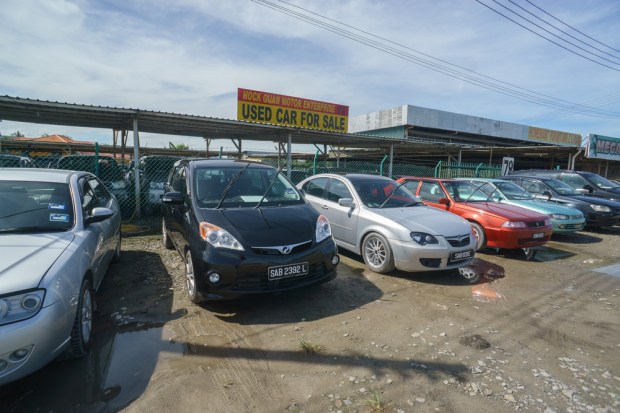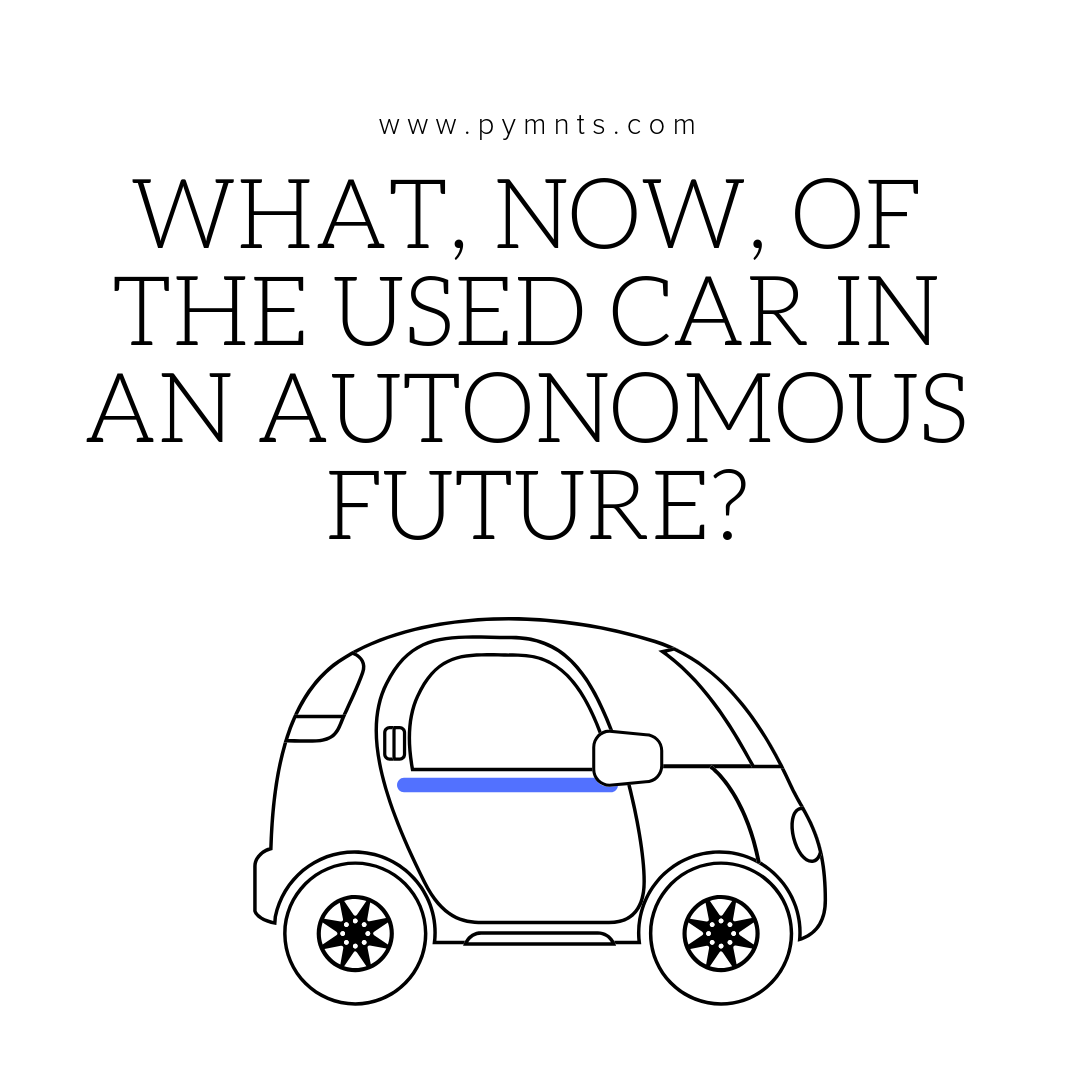What, Now, Of The Used Car In An Autonomous Future?

Let us now praise the used car.
Let us praise the used automobile, even as self-driving cars and trucks promise to disrupt the automotive industry and culture — and the larger economy — in ways as significant as the construction of the interstates and the success of imported vehicles in the U.S. market.
Let us now praise the used car, even as observers looking into the long term can see pictures of their decline.
No ‘Pre-Owned,’ Please
Let us start by rejecting the term “pre-owned.” Instead, let’s agree to stick with, and respect, the term “used car.”
That old-fashioned term is crisp, clear and precise.
“Used car” does not seek to hide the reality of the product beneath a thin blanket of marketing fuzziness. “Used car” may bring to mind thoughts of lemons, consumer protection laws and salesmen with too much cologne and bright, multi-patterned ties. But “pre-owned,” ironically enough, comes across as an adjective born of a focus group for con men trying to come up with a soft, harmless term to mask their chicanery. (While we are on matter of words, let us also vow to never again say “mixologist.” When did “bartender” become a job title that needs forced glorification? Is all blue-collar language to be purged from U.S. culture in favor of five-star pretentiousness?)
Used Car Trends
Anyway, back to the praising …
Used car sales and prices are having a bright moment. Sales increased 1.6 percent year over year in 2017, to 39.2 million vehicles, according to Edmunds. That growth comes from “increased replacement demand due to Hurricanes Harvey and Irma and increased used inventory due to a glut of off-lease vehicles hitting the used market in 2017.”
Consumer desire for affordable transportation is also contributing to growth in the used car sector, and increased demand for those vehicles pushed used car prices up 1.4 percent in 2017.
Consumers shopping for used cars are especially interested in compact and midsized models, according to Cox Automotive, which said that wholesale used car prices increased 2 percent month over month in August, an “abnormal summer bounce” that began in June.
“As of Labor Day, three-year-old vehicles are now worth 4.8 percent more than they would normally be worth had typical depreciation occurred instead of the appreciation observed this year,” Cox said. The prices are “partly a function of a strong economy at its peak, with mounting affordability challenges for the consumer that favor growth in used vehicle sales at the expense of new. These conditions have supported strong used vehicle prices for over a year.” Consumers also fear the price impact on imports thanks to building trade wars, and anticipate higher interest rates — two more factors “behind the vehicle appreciation this summer.”
That said, other recent data signals that used cars are depreciating at a faster rate in the past few years because of a surge in the prices of new cars.
Even so, companies in the automotive industry are trying to grab a larger share of the used car market, and are relying on digital technology to make that happen. Volkswagen, for instance, launched an online platform for used car sales, where the manufacturer lists high-margin used cars in order to target German pre-owned (sorry, used car) vehicle markets, where 95 percent of online sales are conducted through the platforms mobile.de and autoscout24.de.
 Future Concerns
Future Concerns
That’s the present. What does the future hold?
In trying to answer that, let us agree to not wallow in nostalgia for the gearhead-and-cruising culture — all those amateur mechanics in their garages, their weekend work leaving grit under their fingernails and grease stains on their arms — that is declining, and may well disappear within a generation or so.
Disruption disrupts.
Things change.
Cultures die.
Fans of the automotive culture — a defining trait of 20th century American society, one that applied to all races and ethnic groups, one that offered various rites of passage to millions upon millions of young consumers (some of those rites being mechanical, some financial, some romantic and/or sexual, all of them involving pride and a new, seemingly unbreakable sense of freedom) — can always cue up “Born to Run” or similar musical or cinematic expressions of automotive glory. (Let us take a detour to praise the 1971 cult classic “Two-Lane Blacktop,” a car-race/muscle-car movie preserved in the Library of Congress, starring James Taylor — yes, the “Fire and Rain” sensitive songwriter guy — and boss enough that you might smell the exhaust or feel the gear shifts.)
“We as Americans associate our identity with our car,” Doug Seven, who leads Microsoft’s connected and driverless car efforts, told Bloomberg earlier this year. “When the 20-year-olds become the 40-year-olds and the 40-year-olds become the 60-year-olds, the cultures will shift.”
Instead of indulging our emotions, let us praise the value of cold observation as we consider the fate of the used car — which, of course, has been a significant enabler of that culture, and a place where so much American life continues to happen.
Fewer New Cars
Private-car ownership is on its way out — or, perhaps less dramatically, will become a much smaller part of economic life — according to a report this year from Credit Suisse, with new car sales in severe decline by 2030. By 2040, Credit Suisse predicts, 14 percent of all vehicles on the road will be fully autonomous. If you desire, you can easily find other, harsher predictions — often from lifelong, Baby Boomer participants in American automotive culture who view the autonomous future as almost a dystopian prospect — who anticipate an even quicker shift than Credit Suisse.
(Gasoline consumption will have declined by 30 percent in 2040, too, Credit Suisse said. That raises questions about the future of gas station and convenience store retail — with that sector becoming increasingly mobile, increasingly integrated to connected-car platforms and increasingly focused on winning over millennial consumers.)
“Our global automotive production chain model forecasts global car production flatlining in 2030, with rising production in developing markets offset by declines in developed markets,” the Credit Suisse report said.
Ridesharing
The reason?
The big one is ridesharing. It will become much more popular, along with “fleets of autonomous vehicles owned by companies (making) up the majority of cars on the roads of developed countries,” according to The Drive.
Consumers will not necessarily need to own those self-driving vehicles. “Autonomous cars will also be able to stay on the road more or less continuously, meaning they can earn more money and customers will have an easier time finding a ride.”
That said, “car buyers will also be able to get good deals, as Credit Suisse expects the rise of self-driving cars to have a negative impact on used car prices,” according to the publication.
Of course, the autonomous wave will hit new cars first, with better technology trickling down to lower-cost vehicles over time. But not every consumer is a first-wave adopter, and automobiles are products that have long lives and multiple owners.
That could present a new — or revised — business opportunity.
“A lot of people will hold out because they take pleasure in driving, they don’t trust being driven around by a self-driving car and/or they live in a more rural area and will still need their own vehicle,” reads a primer from Autosoft written for dealerships owners. “Vehicles with (higher-level) automation features are expected to become very popular for the used car sector. In addition, used cars will allow owners to upgrade to vehicles with even better technology faster as it becomes available.”
None of this is meant to suggest that owners of used vehicles are acting as neo-Luddites, of course, or will be doomed to make do with seemingly primitive technology. Used vehicles already sport connected-car technology, which will only improve as the years pass.
That said, used vehicles may present a bigger opportunity for criminals or perhaps malicious pranksters as the connected car ecosystem develops — at the least, that technology in used vehicles could frustrate their new owners.
That’s because the previous owner of that vehicle could still retain control over vital, web- and mobile-enabled functions, including door entry, climate control and navigation. That’s what Matt Watts, data strategist and director of technology at NetApp, found after he recently bought a used car. He focused the blame on process. After failing to fix the problem himself, he sent the relevant car ID information to the car manufacturer — the dealership offered no help — and received this frustrating reply:
“We are not in a position to remove owner without their permission, previous owners would normally disconnect before they sell the car or if we took in part-ex we would have their written authority to remove from system. I would suggest you contact previous owner and ask them to disconnect their car from the system (this can be done by them on their App), when this is carried out we would be happy to connect you with proof of ownership.”
Watts summed up the issue this way: “Someone else has access to a significant amount of data about myself and my vehicle and there appears to be nothing that the manufacturer is prepared to do about it.”
Continuing Role
As the automotive industry turns ever more into a software provider that happens to consume a lot of steel, rubber, glass and plastic, it seems the used car still has a robust future ahead of itself, at least for a few more decades. Let us take this moment, in fact, to offer respectful praise for the vital role that used cars play in the daily lives of lower-income consumers — who, as some observers remind us, will not enjoy the first-wave, or even second-wave, benefits of autonomous vehicles.
As a Jalopnik columnist asked: “If then we rely entirely on subscription or per-use fees for autonomous cars we don’t own, would that really be a cheaper experience for people” with incomes too low to buy those new vehicles? “Will that autonomous pod really be there whenever the kids get sick, when they need to be at school, when they need to be at the soccer game—and how much do the rides cost?”
Such concerns could, of course, lead to business opportunity. And issues faced by low-income consumers could lead to even more useful years — or decades — for the used car (maybe “pre-owned” will be replaced by another crafted phrase meant to add sizzle to that product as car technology continues to develop). Let us not look back on the used car with nostalgia. The past is not returning, at least not in the larger automotive industry and the other sectors it supports.
But that doesn’t mean the used car will be out of place in the future.
